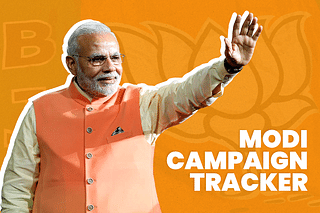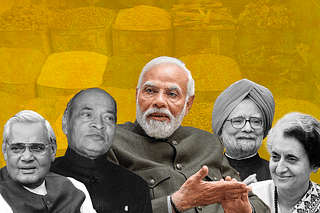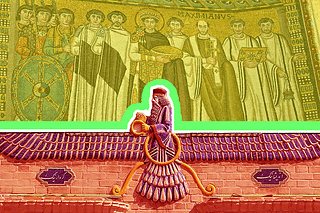Culture
Are Hindu Marriage Vows Misogynistic?
Aditi Banerjee
Dec 17, 2014, 07:08 PM | Updated Feb 10, 2016, 05:19 PM IST
Save & read from anywhere!
Bookmark stories for easy access on any device or the Swarajya app.
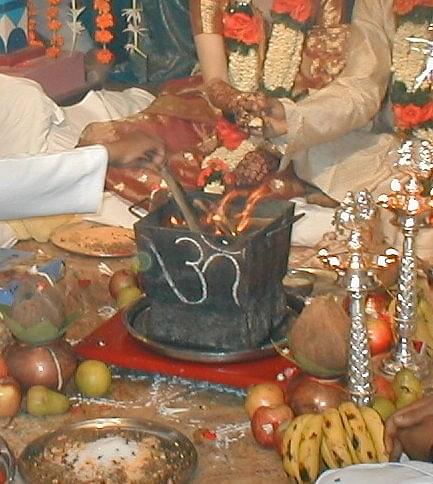
Should Hindu Marriage vows be rewritten to suit the times? The answer, as a study of the shastras show, is an emphatic No.
As quoted by Swami Vivekananda, in the Ramayana, once Rama and Sita had gone to visit a female sage in the forest during their banishment:
“Sita approached this sage and bowed down before her. The sage placed her hand on the head of Sita and said: “It is a great blessing to possess a beautiful body; you have that. It is a greater blessing to have a noble husband; you have that. It is the greatest blessing to be perfectly obedient to such a husband; you are that. You must be happy.”
Sita replied, “Mother, I am glad that God has given me a beautiful body and that I have so devoted a husband. But as to the third blessing, I do not know whether I obey him or he obeys me. One thing alone I remember, that when he took me by the hand before the sacrificial fire — whether it was a reflection of the fire or whether God himself made it appear to me — I found that I was his and he was mine. And since then, I have found that I am the complement of his life, and he of mine.”
Groom to Bride during the Hindu wedding ceremony (translated from Sanskrit):
“I am the sky, you are the earth. I am a song of the Samaveda, you are a Rik, a couplet of the Rigveda; I am thee and thou art me. We are married. Let us get virtuous progeny, who will be lovable, lustrous for us. Let us lead a long life in togetherness to enjoy one hundred autumnal seasons.”
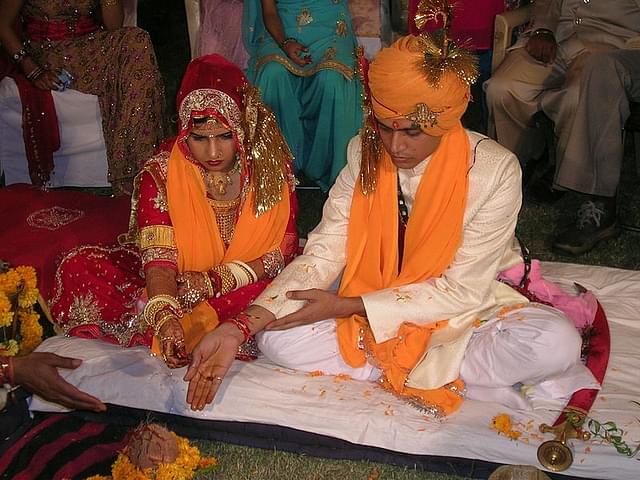
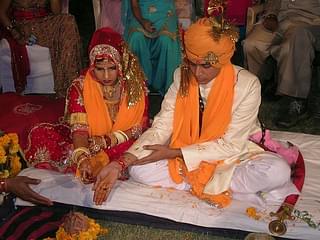
In a recent column in Business Standard, Mitali Saran argues that Hindu wedding vows should be updated or rewritten by couples for the sake of gender equality. Her basic complaint is that the Sanskrit shlokas used for the wedding ceremony envision a specific division of labour (the woman doing the household work and the man earning for the family while being served by his wife at home) that is unfair to working women in today’s world. The column is rather shallow and gratuitously provocative, but raises two serious questions that deserve to be answered:
1. Are the Hindu marriage vows inherently misogynistic?
2. Even if those vows were once appropriate, have they become obsolete today?
There is enormous intricacy and subtlety in the rites of Hindu marriage, and there is also significant variation across different regions, sampradayas (religious traditions), and jatis (clans / socioeconomic groups). The importance of various rites and their different layers of meaning and symbolism deserves its own series of articles, but the focus of this piece will be on the saptapadi mantras, which are the mantras uttered during the seven rounds taken by the bride and groom around the consecrated fire.
The groom leads the bride around the fire for the first three rounds; the bride leads during the last four (which also shows their inherent equality in stature—sometimes the husband leads, sometimes the wife).
The vows themselves are as follows:
Bride and Groom together:
Let us walk together, hand in hand, the seven steps symbolic of the aspirations below:May We take the first step together for sap (nourishment),
May We take the second step together for vigour,
May We take the third step together for thriving wealth,
May We take the fourth step together for comfort,
May We take the fifth step together for offspring,
May We take the sixth step together for the various seasons,
May We take the seventh step together for everlasting friendship.
You be my unswerving partner; (let us have many auspicious progeny who shall see long life crossing 80 years)
Personally, I find these vows to be extraordinarily rich and multifaceted, reflecting deep psychological and sociological insight into the various needs and phases that a married couple goes through. We do not see in these vows the misogyny alleged by Saran.
However, there is variation in the exact customs followed across regions and sociocultural groups according to various Grihya Sutras, and there appear to be certain interpretations or variations of these vows where the bride promises to cook for and please the groom, which is Saran’s main grievance.
Without getting into a lot of arcane debate about whether these alternative interpretations are authentic or interpolations, let us assume for the sake of argument that Saran is correct that in these vows there is emphasis on the bride’s promise to take care of the family, feed the family and serve and please her husband with no such corresponding vow required on the husband’s part. Even in such a scenario, the basic point is that a division of labour is not in and of itself unequal or derogatory towards woman.
There are differences in male and female psyches that lead to certain qualities predominating in men and others in women—as a general matter, not to be taken to extremes—and specialization in certain roles tends to optimize the different qualities in men and women for the benefit of all. (In fact, to characterize the role of women in the household as being secondary to office work or business is based on the sexist premise that the domain of the home is inferior to the domain of the workplace. Perhaps it is the husband who should be considered oppressed because he does not get to spend enough time at home!)
This does not mean that those gender roles are ossified for all times and in all circumstances—this is one model for society, and in the context of that model, these vows are entirely appropriate and cannot be considered to be derogatory towards women.
Saran’s chief complaint is that the bride is reduced to the lowly status of a maidservant. But in the Hindu conception of marriage and womanhood, as reflected in the shastras and the ordained rites, the bride is not at all a maidservant—rather, she is the one who reigns over the household.
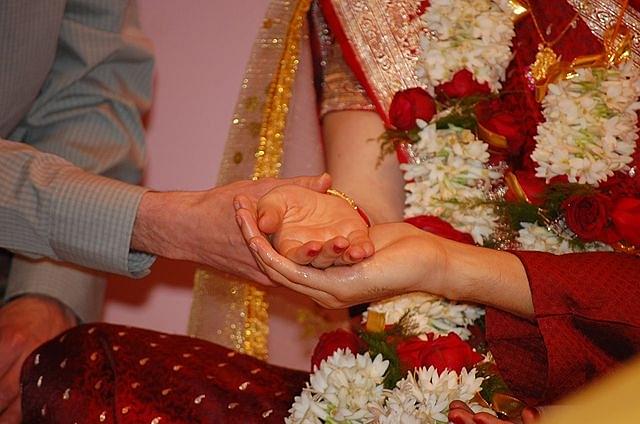
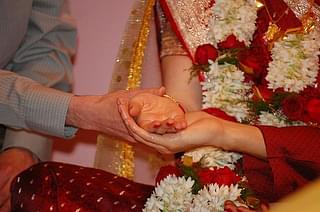
The Sanskrit term for a wife is grhini, which means the owner of the house, whereas the term for husband, grhastha, means a mere resident of the house. If the wife were to have the same status as the husband, she would be known as a grhasthaa. In Tamil, too, the wife is illaal, one who owns the house, whereas the husband is illarattaan, one who performs the dharmic rites in the house.
The conception of the wife as reigning over the household stems from the Vedas themselves. In the Rg Veda, we find these beautiful quotations:
“Happy be you (as wife) and prosper with your children here (in the house): be vigilant to rule your household in this home (i.e. exercise your authority as the main figure in your home). Closely unite (be an active participant) in marriage with your husband. So shall you, full of years, address your company (i.e. have authority to speak over household matters).” (10.85.27);
“O Bride! May your father-in-law treat you as a queen. May your mother-in-law treat you as a Samrajni (queen). May the sisters and brothers of your husband treat you as a queen.” (10.85.46).
If we have fallen away from these ideals in the recent past, the fault lies in social decay and not in the beliefs and traditions that our rishis have passed down to us.
Unlike Saran, who seems to think that the work a woman does at home is demeaning, our acharyas and rishis held women in great reverence for the importance of their work and role, not just in the family but in society, and for the depth of their devotion and sacrifice.
In traditional Hinduism, the wife plays a fourfold role: she is ardhangini (the other half of her husband, metaphorically speaking); sahadharmini (partner in the fulfilment of human and divine goals—principally, the four purushartha, or aims of human life: dharma, artha (accumulation of wealth through righteous means), kama (fulfillment of desire through appropriate means) and moksha (self-realization; liberation from the cycle of birth and death)); sahakarmini, (partner in all acts and actions), and sahayogini (partner in all ventures).
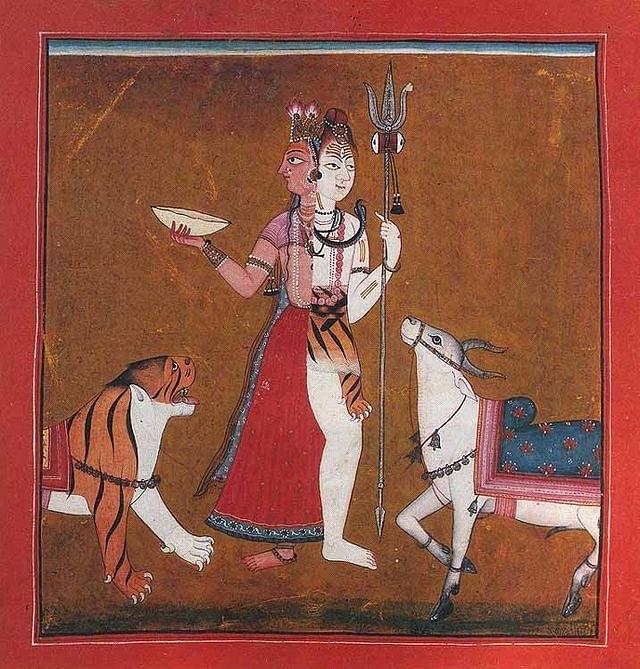
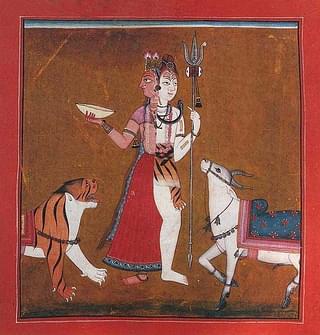
Moreover, the wife’s role was not merely to ‘please’ her husband:
“It must be noted that a wife creates well-being for the world even as she does the work of cooking or as a source of sensual gratification for her husband… It is not that she cooks for the husband alone. She has to provide food every day to the guests, to the sick and to the birds and beasts and other creatures. This is how she serves the purpose of atithyam (serving unexpected guests) and vaisvadevam (serving sentient beings).”
In Hinduism, the role of cooking and feeding is not that of a lowly servant—it is a divine role manifested in the form of Annapurna Devi, the goddess of food and nourishment, from whom even Lord Shiva receives bhiksha (food gathered as alms through begging).
As eloquently explained by Swami Vivekananda:
“Why should the Hindu mother be worshipped? Our philosophers try to find a reason and they come to this definition: We call ourselves the Aryan race. What is an Aryan? He is a man whose birth is through religion. This is a peculiar subject, perhaps, in this country; but the idea is that a man must be born through religion, through prayers. If you take up our law books you will find chapters devoted to this—the prenatal influence of a mother on the child.
I know that before I was born, my mother would fast and pray and do hundreds of things which I could not even do for five minutes. She did that for two years. I believe that whatever religious culture I have, I owe to that. It was consciously that my mother brought me into the world to be what I am. Whatever good impulse I have was given to me by my mother—and consciously, not unconsciously.
…
The mother has to eat last. I have been asked many times in your country (the United States) why the (Hindu) husband does not sit with his wife to eat—if the idea is, perhaps, that the husband thinks she is too low a being. This explanation is not at all right.
…
The first part of the food—when it is ready—belongs to the guests and the poor, the second to the lower animals, the third to the children, the fourth to the husband, and last comes the mother. How many times I have seen my mother going to take her first meal when it was two o’clock. We took ours at ten and she at two because she had so many things to attend to. [For example], someone knocks at the door and says, “Guest”, and there is no food except what was for my mother. She would give that to him willingly and then wait for her own. That was her life and she liked it. And that is why we worship mothers as gods.”
The late Shankaracharya of Kanchi Kamakoti Peetham, Sri Sri Chandrasekharendra Sarasvati Svami, explains that one of the three objectives of marriage is “to create a means for women (and men) to be freed from worldly existence. A man who is not yet fully mature inwardly is assisted in his karma by his wife. By doing so, by being totally devoted to her husband, she achieves maturity to a degree greater than he does.”
In return for the indispensable help a dharma-patni renders to her husband in carrying out his dharma and evolving spiritually, half of whatever punya karma (spiritual merit) the husband attains is transferred to her. On the other hand, none of the paapakarma (spiritual demerit) of her husband inures to her, and none of the punya karma of the wife is transferred to the husband.
So we see that in the marriage vows themselves and in the Hindu conception of woman and her role as a wife, she was in no way a mere maidservant or meant to be an appendage to serve her husband. Her role was much greater than that, and she was given due respect, reverence and recognition for her devotion and sacrifice that benefitted not just her husband, but also her own spiritual evolution and the society at large.
We now come to the second question, which is whether changes in the modern woman’s role at home and in the workforce render the Hindu wedding vows somehow obsolete. The question itself is based on a false premise that these vows are meant to be prescriptive in a literal sense. The Hindu conception of marriage is much more nuanced and diverse than that.

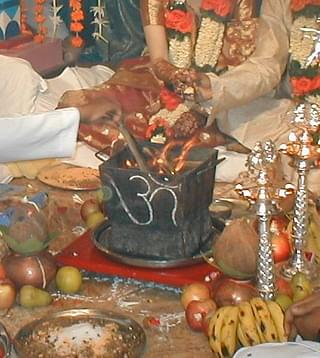
Traditionally, Hinduism recognizes eight forms of marriage: brahma (considered to be the highest form of marriage, where the groom’s parents approach the bride’s parents for kanyadana (giving away of their daughter to the others’ son)—here, the bride is sought out by the groom’s family); daiva (where the bride’s parents seek a groom in the area where sacrifices are performed and marry her to a priest who officiates the yajna); arsa (where the bride is given in exchange for two cows from the groom’s family, or alternatively, where the bride is married to a rishi); prajapatya (the same as the brahma style, but the bride’s parents must approach the groom’s parents instead); asura (where the groom is not a match for the bride, but money is given to the bride and her family in exchange); gandharva (where the bride and groom unite out of their own desires); raksasa (forcible abduction of the bride against the wishes of her family (but not necessarily of the bride herself)—this is the form in which Sri Krishna married Rukmini); and paisaca (where the bride does not or is unable to consent—for example, when a man seduces a girl who is unconscious or mentally incapacitated).
Even though the last two forms of marriage are generally discouraged by the shastras and our acharyas, they are recognized for a reason. In Hinduism, shastras are made for man; man is not made for the shastras. In other words, the shastras are developed based on the sociological reality of the day. That is why the smrti are ever-changing, and it is only the Vedas (sruti, that which has been revealed or heard) that are unchanging and eternal.
The Dharmashastras are meant to apply based on time, place and circumstance. Our shastras are not meant to be one-size-fits-all, and thus provision is made for diversity in cultures, customs and personality types. For example, those who are more accustomed to pleasure and sense gratification would be more likely to engage in the gandharva form of marriage.
Similarly, even though the raksasa and paisaca forms of marriage may be unethical, our shastras grant them some recognition so that, to the extent they occur, some provisions may be made for safeguarding the honour and dignity of the woman; however, because they are expressly disapproved of, their occurrence is meant to be minimized as much as possible.
No matter which form of marriage applies, the marriage vows are, at the core, the same. Why? Because there is a bhavana (feeling / state of mind / attitude) and code of values that underlies these Sanskrit shlokas that is universal—they are meant to promote certain vrttis (waves within our consciousness) and lakshanas (qualities that promote masculine virtues for the groom and feminine virtues for the bride).
The vows are not just the bride and groom promising fidelity to each other, but, at a deeper level, are a commitment to being partners who will together care for their families, observe together all of the rites and sacrifices enjoined by the Vedas in the spirit of loka sangraha (wellbeing for the world/ cosmos) and be companions who give comfort and strength to each other. These mantras sanctify and cement a bond between husband and wife and their respective families, and they promote social harmony by guiding couples on how to perform their individual and familial dharma.
No matter what form of marriage is chosen or what socioeconomic roles are assumed by the husband and wife, these core vows are applicable to all—they are the bonds through which a lifelong partnership are formed.
These mantras encode the blessings and tapasya (spiritual power) of our ancestors and devas, our rishis and acharyas, who are invoked through the marriage ceremony, and such mantras are not to be tampered with lightly.
It is not equivalent to the modern practice of couples writing vows to each other based on their personal feelings—there is nothing wrong with that practice but such vows should supplement, not supplant, the core mantras from the vivah samskara (the Hindu marriage rites).
There is a current of energy, of blessings and power in these mantras and rites, which transforms a marriage from a social contract and emotional bonding to a sacred covenant that is strong and lifelong (or, rather, seven lifetimes long).
The taking of Hindu marriage vows with utter sincerity and faith does not preclude a husband and wife from arranging (and rearranging) between themselves their roles within and without the household in new ways.
Hinduism does not promote a cookie cutter mould of our marriage—ours is a tradition that honours the Panchakanya (Ahalya, Draupadi, Sita or Kunti, Tara and Mandodari), venerated as the five ideal Hindu wives, although, in their own way, each of them led an unconventional married life.
The conception of Hindu marriage does not preclude a woman from working or a man from being a house husband. But there needs to be serious reflection on all of the important roles played by a married couple in the Hindu conception of society and how those roles and responsibilities may be carried out equitably in these new scenarios.
We cannot just discard those duties that have been enjoined upon as, but we can find new ways of carrying out those duties—for example, if people feel that Karva Chauth is too one-sided, nothing stops the husband from also fasting on that day (as I know many men do nowadays).
That would be a much healthier alternative than simply stopping the observance of Karva Chauth, as this is a vrata that strengthens the marital bond and also the bond between the bride and her new family. The integration of worship with the marital relationship in Hinduism makes Hindu marriages uniquely sacred and powerful, and we cannot lose that sacred link out of some cheap politicization of the gender wars.
When we understand the spirit of the Hindu wedding rites and mantras, the depth of feeling and philosophical intent behind them, it is impossible to think that they are inherently misogynistic.
Yes, it is true that the rites and mantras have been, through social custom, often interpreted in misogynistic ways. But that was not the original intent of the vivaha mantras. These mantras can be and should be understood, in spirit, in a way that is in harmony with the world in which we live today. That has always been the Hindu way.
That is why there are so many different Dharmashastras / Grihya Sutras—they have to be relevant to differing times, places and circumstances. That is what makes our spiritual tradition so unique—the flexibility of our shastras to encompass a wide variety of practices, beliefs and traditions while still retaining a universal framework of principles and values that applies to them all.
with special contributions from Dr BVK Sastry
Save & read from anywhere!
Bookmark stories for easy access on any device or the Swarajya app.
Aditi Banerjee is a practicing attorney at a Fortune 500 financial services company in the greater New York area. She is on the Board of Directors of the World Association for Vedic Studies (WAVES) and has organized and presented at global conferences on matters related to Dharma. She co-edited the book, Invading the Sacred: An Analysis of Hinduism Studies in America, and has written widely on Hinduism and the Hindu-American experience.
Introducing ElectionsHQ + 50 Ground Reports Project
The 2024 elections might seem easy to guess, but there are some important questions that shouldn't be missed.
Do freebies still sway voters? Do people prioritise infrastructure when voting? How will Punjab vote?
The answers to these questions provide great insights into where we, as a country, are headed in the years to come.
Swarajya is starting a project with an aim to do 50 solid ground stories and a smart commentary service on WhatsApp, a one-of-a-kind. We'd love your support during this election season.
Click below to contribute.

